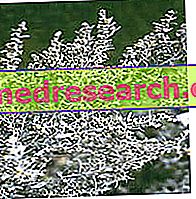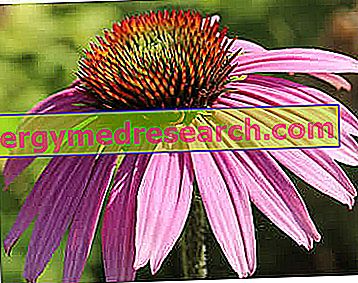By Dr. Rita Fabbri
... The name of the plant "Absinthium" derives from the Greek, literally we can translate it as " plant without pleasure " meaning unpleasant plant; this is because absinthe is a bitter plant in all its parts. The name of the genus "Artemisia" seems to derive from Artemis, the protective goddess of medicinal plants that benefit women. Artemisia absinthium is also called "holy grass" due to its medicinal properties. In fact, the Absinthe is the “bitter aromatic” plant par excellence of the herbalist tradition, it acts as a stimulant appetite, digestive, vermifuge; it also re-establishes the physiological menstrual rhythm, but is also highly toxic.
Absinthe is widely used to flavor liqueurs, including Vermouth, a liqueur wine with a pleasant bitter-tonic taste due to its Absinthe. Absinthe yielded an "illegal" liquor that gives symptoms similar to soft drugs. Vermuth, however, contains only bitter substances but no essential oil, in fact it is not harmful. Absinthe as intoxicating was also celebrated in art. Shakespeare has Hamlet say "Absinthe! Absinthe!" Manet, father of impressionism, paints "The drinker of absinthe", Degas "Absinthe". Baudelaire, Verlaine, Rimbaud, the "cursed" poets, wrote getting lost in the sips of his alcohol. The Absinthe is still produced today but with lesser quantities of thujone.The Absinthe is a plant really very bitter enough to become proverbial for this its characteristic: already in the Sacred Scriptures it symbolized the difficulties of life and sometimes it is used to say "it is bitter as absinthe". In some treaties of the late Middle Ages the Absinthe is cited as "the plant that benefits because it excites the appetite and preserves the clothes from the moths ”.
 | Botanical name : Artemisia absinthium L. Family : Compositae Parts used : leaves and flowering tops |
Botanical description
The Artemisia genus includes several plants characterized by gray-green leaves. Absinthe in particular has silvery, velvety, serrated leaves; the flowers are small, inconspicuous, yellow in color. Absinthe is a perennial herbaceous semi-bush, probably originating in central-southern Europe or perhaps in Asia, it grows spontaneously in rather arid and uncultivated soils with calcareous or siliceous substratum is a common plant on the walls and in the vicinity of the inhabited centers of the regions mountain and submontane. The ideal climate is temperate, it prefers a sunny and sheltered position, it resists well to high temperatures but suffers great cold; the flowering period is summer.
Absinthe is grown in gardens mainly as a decorative border. Spraying generously fruit plants and herbs from the garden with an infusion of water and wormwood left to macerate for a few days, you will notice a strong reduction in pests, caterpillars and snails without resorting to pesticides.
Chemical composition
Sesquiterpene lactones that give the bitter taste to the drug. Essential oil with a remarkably variable composition depending on the origin and the chemotype but containing mainly β-thujone and in a lower quantity α-thujone. The toxicity of absinthe is due to the tujone and its metabolites. Other constituents include flavonolic glucosides, phenolic acids, tannins.
Therapeutic indications
Widely used as an amarotonic, eupeptic (it facilitates the digestive function), choleretic and cholagogue (it facilitates the biliary secretion towards the intestine and the secretion of the bile by the hepatic cells), useful in the inappetence that occurs for example after periods of stress or after a convalescence, in dyspeptic disorders, gastric atony and inflammation of the gastro-intestinal mucosa. It is less used as a vermifuge and as an emmenagogue (regulates menstrual flow), the latter due to the thujone.
Absinthe also exerts a protective effect in the liver, which appears to be partially associated with the inhibition of hepatic microsomal enzymes. A study carried out on rats showed that the plant's raw extract is able to exert - on rodents - preventive and curative action against paracetamol and carbon tetrachloride-induced liver injury (CCl 4 ): two experimental models of hepatotoxicity that are used very frequently.
The daily dose for adults is 1-1.5 g of drug for 150 ml of water in infusion or as a decoction up to 3 times a day. In the event of loss of appetite, it is advisable to take half an hour to an hour before meals; in the case of dyspeptic disorders to be taken warm after meals. Absinthe should not be taken continuously and in any case not more than a month.
Contraindications, special warnings and appropriate precautions for use, undesirable effects
It is contraindicated in cases of gastric and duodenal ulcers. Absinthe should not be used during pregnancy and lactation. No side effects when taken at recommended doses. The toxicological risk is considered to be very low. The symptoms associated with Absinthe overdose are vomiting, diarrhea and exhaustion.
Overdose of absinthe-based alcohol preparations or the use of essential oil may cause:
- epillettiform convulsions
- breathing difficulties
- hypotension
- decrease in heart rate
In the past (19th and 20th centuries) it was believed that the abuse of the absinthe-based liqueur was responsible for the onset of "absintism", a syndrome characterized by an initial feeling of well-being followed by hallucinations and convulsions.
Recently it has been pointed out that the convulsive epilletiform phenomena would be due not so much to the rather low content of thujone present in the liqueur prepared according to the original recipe, but to the chronic intake of an alcoholic - characterized by high gradation - where they are present as adulterants, some toxic herbs ( Acorus calamus, Tanacetum vulgare ) and substances such as zinc or antimony chloride.
Historically, the inventor of the liqueur was a French physician, Pierre spectacular, who after escaping from the French Revolution settled in Couvet, Switzerland. His Absinthe became extremely famous as a panacea and was called the Fée Verte (the Green Fairy because of its pale green color). It is said that at his death Ordination left his secret recipe to the sisters but some believe that the sisters produced their Absinthe already long before Pierre Ordinance. Many distilleries appeared in France and Switzerland producing different brands of Absinthe. The recipe shown below is one of the many variants used at the artisan level:
The following dried medicinal plants are left to macerate for at least 12 hours in 1 liter of 85 ° alcohol:
- Artemisia absinthium 25 g
- Anise 50 g
- Fennel seeds 50
- Small portions of juniper, nutmeg, veronica, star anise, angelica, lemon juice
0.5 liters of water are added to the obtained extract, and the solution is placed in a distiller. The distillation process must be interrupted when 1 liter of distillate has been obtained. 0.4 liters of the distillate are taken and the following are added:
- Artemisia absinthium 10 g
- Hyssop 10 g
- Lemon juice 5 g
The extract obtained is heated to a moderate temperature and filtered; the remaining 0.6 liters of distillate are added to the filtrate. The approximately liter of final Absinthe should be diluted with water until it reaches an alcohol content of 75 °.



